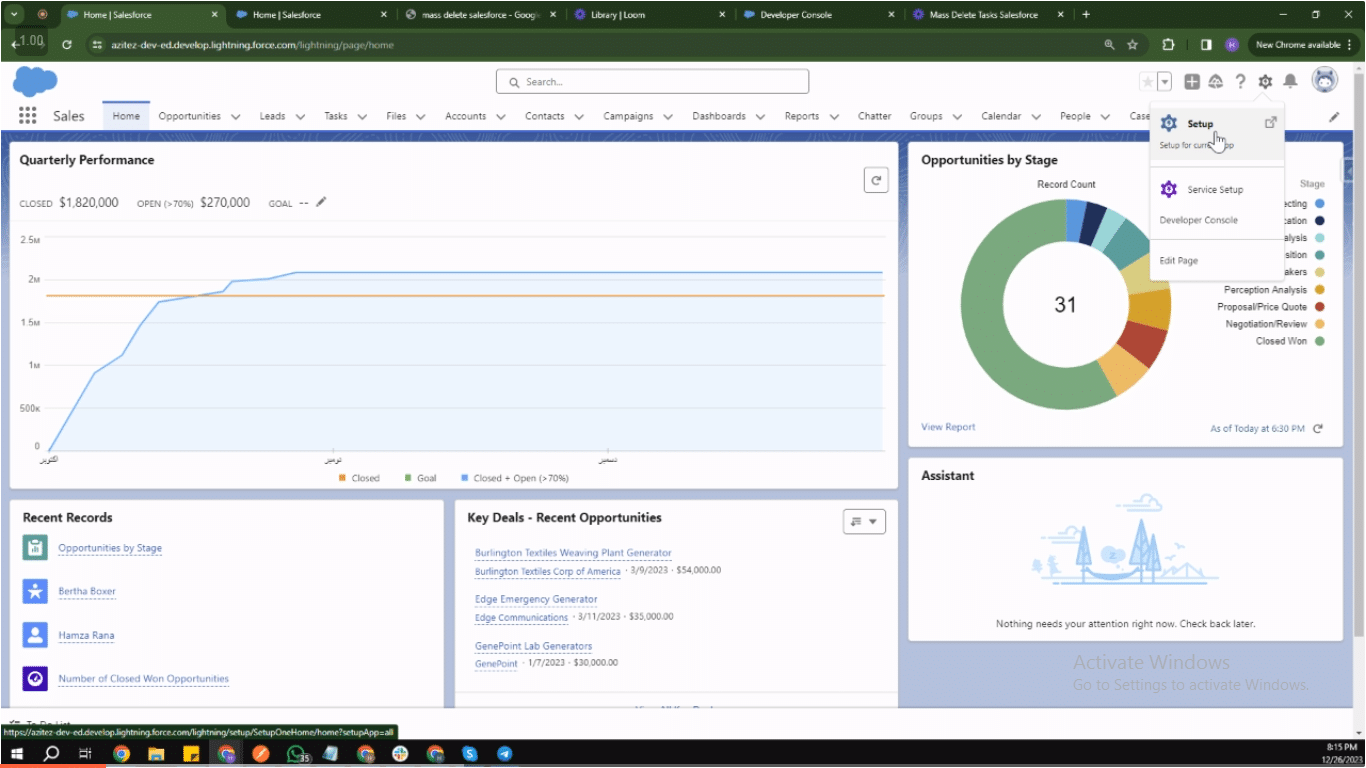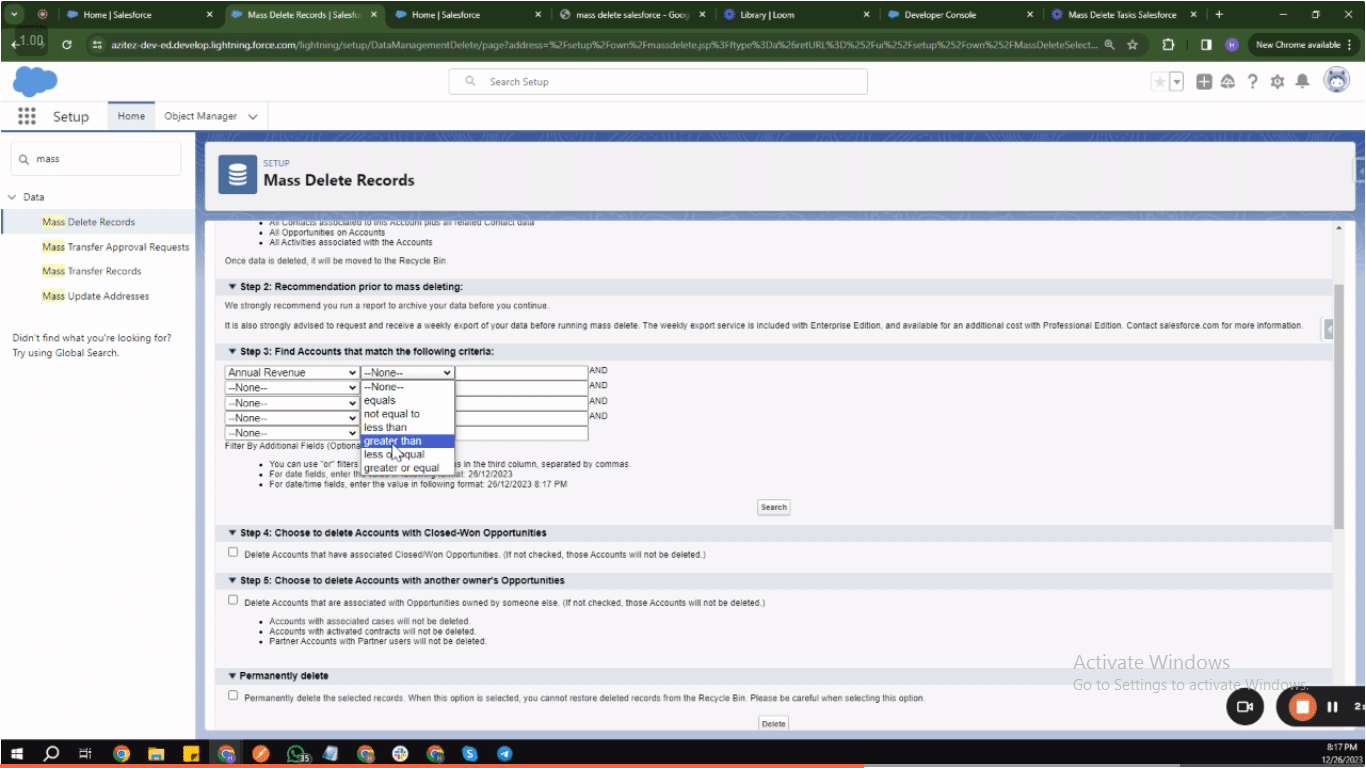Effective Salesforce data management involves periodic cleanup to maintain optimal system performance. The mass record deletion feature streamlines this process, allowing users to remove multiple records safely.
Follow this step-by-step guide to learn how to mass delete records in Salesforce.
Let’s dive in!
Step-by-Step Guide to Mass Deleting Records in Salesforce
Step 1: Accessing Setup. Begin by navigating to the top-right gear icon for settings in your Salesforce account. Select the “Setup” option from the menu, which will open in a new tab.

Step 2: Locating Mass Delete Records. Once in the setup menu, use the top-right search bar to find “Mass Delete Records.” Click on the search result to open the “Mass Delete Records” page.

Step 3: Choosing Record Types. On the “Mass Delete Records” page, you can delete up to 250 records at a time. Identify the record types you want to delete, such as accounts, leads, activities, contacts, cases, solutions, products, or reports.
Step 4: Accessing Mass Delete Menu. Click on “Mass Delete Accounts,” which is typically the first option on the page.

Step 5: Navigating through Steps. Carefully review the steps presented on this menu to ensure a thorough understanding of the mass deletion process.
Step 6: Applying Filters and Fields. Specify the filters and fields based on which you want to delete records. This step helps you narrow down the selection to ensure accuracy.

Step 7: Reviewing Selected Records. Once filters are applied, the relevant records will be displayed below. Review the list to confirm that the selected records align with your intended deletions.
Step 8: Selecting Records for Deletion. Mark the records you wish to delete by checking the corresponding checkboxes.

Explore 8 cutting-edge techniques that are revolutionizing how Salesforce admins manage their daily tasks. Contribute more significantly to business outcomes and become a key driver of efficiency and innovation.
See the Techniques

Step 9: Permanently Deleting Records. With the desired records selected, click the “Delete” button to remove them from Salesforce permanently.
Best Practices for Mass Deleting Records from Salesforce
When engaging in mass record deletion as part of Salesforce data management, it’s crucial to follow precautions and strategies to ensure a safe and effective process.
Precautions Before Mass Deleting Records
- Backup Your Data: Before initiating any mass record deletion, create a backup of the data. This step serves as a safety net in case of accidental deletion or the need for historical reference.
- Understand Dependencies: Identify any dependencies or relationships between records. Deleting records that are linked to others could disrupt business processes. Understanding these connections helps avoid unintended consequences.
- Implement Access Controls: Limit access to the mass deletion functionality to authorized personnel. Implement strict user access controls to prevent accidental or unauthorized deletions.
- Thoroughly Review Selections: Before confirming the deletion, carefully review the selected records. This ensures that only the intended data is removed and prevents the loss of critical information.
Strategies for Data Integrity After Mass Deleting Records
- Audit Trails: Enable audit trails to track changes made to the Salesforce environment. This allows for post-deletion analysis and identification of any issues that may arise.
- Regular Data Audits: Schedule regular data audits to identify and remove obsolete records before they accumulate. This proactive approach reduces the need for large-scale mass deletions.
- Documentation: Maintain documentation of the deletion process, including the reasons behind the deletion and the criteria used for selection. This documentation serves as a reference point for future data management decisions.
Conclusion
Mastering the mass deletion of records in Salesforce is a pivotal aspect of effective data management. The careful execution of mass record deletion is essential to avoid unintended consequences, such as data loss and disruption of business processes.
To further enhance Salesforce data management, consider leveraging tools like Coefficient. Coefficient offers advanced features for data cleanup strategies, providing a comprehensive solution for maintaining a streamlined and efficient Salesforce environment.
With Coefficient, users can not only perform mass record deletion with confidence but also gain insights into their data, enabling informed decisions for improved data integrity. Explore more at Coefficient and elevate your Salesforce data management experience.
As businesses continue to rely on Salesforce for comprehensive customer relationship management, efficient data management becomes significant.


